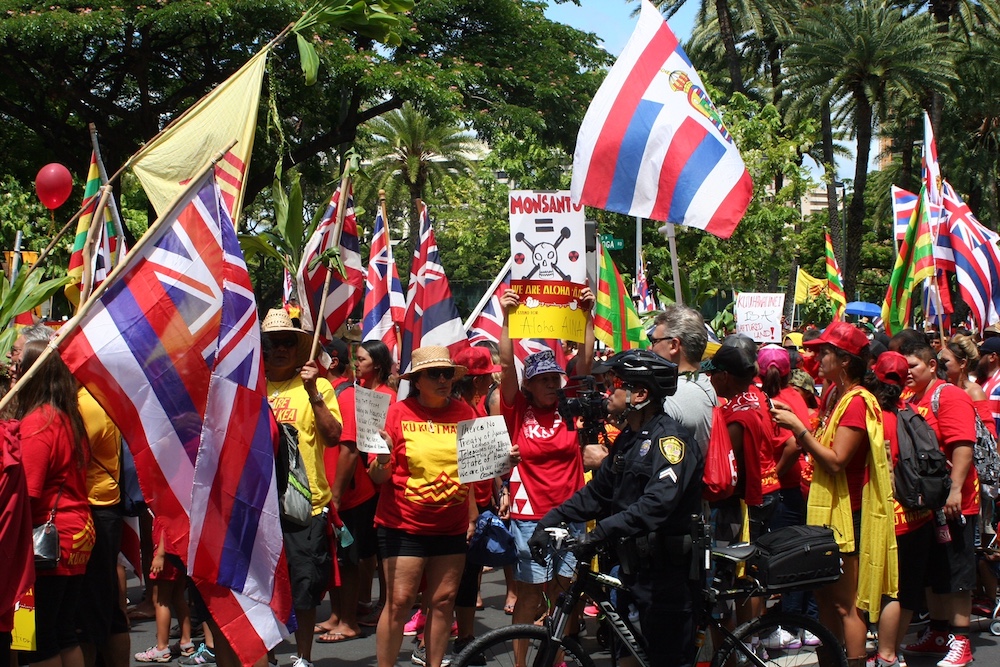Hawaii Will Finally Force Companies to Say What Pesticides They’re Spraying

On a former sugar plantation on the dry southeast coast of Kauai, Hawaii, far from the tourist beaches, agrochemical companies are testing a secret cocktail of toxic pesticides on genetically modified corn. Now, after years of campaigning, residents who live around the test site have earned the right to know exactly which toxic pesticides are being sprayed.
On Wednesday (June 13), Hawaii Gov. David Ige signed a landmark bill that was passed unanimously by both houses of the state legislature. For the first time in Hawaii, the law will require these corporations to reveal, once a year, exactly where, what and when they have sprayed the most toxic category of pesticides, termed restricted-use pesticides. These include herbicides (the biggest category), insecticides and fungicides (the smallest). [Infographic: Pesticides in Fruits and Veggies]
Kauai's cornfields, where genetically modified corn is tested for its resistance to pesticides, receive 17 times more restricted-use pesticides than the average mainland cornfield, according to a study by the Washington, D.C.-based environmental nonprofit Center for Food Safety. Similar seed farms are operated on Oahu, Molokai and Maui (but not the Big Island or Lanai).
The new law also forbids companies from spraying pesticides within 100 feet (30 meters) of schools during school hours. In addition, by 2022, the law will ban the use of the insecticide chlorpyrifos, which has been linked to developmental problems in children as well as several cancers. Hawaii is the first state to ban the chemical, at a time when the U.S. Environmental Protection Agency (EPA) recently reversed a recommended U.S. ban on it that was initiated by the Obama administration.
Prior state law required the companies to report once a year what restricted-use pesticides they brought into the state and on what island they were used, but the new law changes that by requiring them to report exactly where and when they sprayed which pesticides. It took three years of lobbying and campaigning the legislature to get the law enacted, said former state Sen. Gary Hooser, one of the leaders of the campaign in Kauai. "I hope this is the start of a new era," he said.
Sunny days for GM corn
Hawaii became the global epicenter of genetically modified corn in the 2000s, when agrochemical companies Monsanto, DuPont Pioneer, Syngenta and Dow Chemical took over prime agricultural land that had been abandoned by sugar and pineapple growers because of cheaper competition from Asia. Most varieties of genetically modified corn are designed to be resistant to the herbicides, insecticides and fungicides sold with it by the same company.
Hawaii's balmy weather allows for three or four crops of genetically modified corn a year, rather than one or two on the U.S. mainland, reducing the time it takes to test and bring a new strain to market from five years to three.
Get the world’s most fascinating discoveries delivered straight to your inbox.
The strains are then sent to the mainland, where companies produce the seed corn that gets sold to farmers, along with the pesticides these crops have been bred to be resistant to.
Under federal law, companies that allow sprayed pesticides to drift outside the target field can be punished with a fine of up to $25,000, and the person doing the spraying can spend up to six months in jail. People are expected to stop spraying if the wind is blowing toward habitations or widely used roads. However, even though complaints of drift on the Hawaiian islands multiplied and spurred 16 school evacuations in eight years, none of these companies was prosecuted.
At a hearing I attended in 2015 in Waimea, near the Kauai corn-testing fields, half a dozen residents rose and told stories of suddenly gasping, coughing and tearing up as they inhaled what they believed to be pesticides, which they said have an unmistakable smell.
Several doctors who spoke to Live Science have said that, to treat patients with symptoms of pesticide inhalations, they need to know what the patients might have inhaled. But the companies report on only about two dozen kinds of restricted-use pesticides, which are not sold to the public, while not disclosing the use of unrestricted ones. The most common unrestricted pesticide, glyphosate — sold as the herbicide Roundup — is "probably carcinogenic in humans," the World Health Organization determined in 2015.
There is some uncertainty as to why the companies don't want to disclose which pesticides they use. Sylvia Wu, a former staff attorney at the Center for Food Safety, told Live Science the companies may be afraid they'll be sued once residents learn what has been sprayed.
"People are going to be outraged when they finally learn what they and their children have been breathing," Hooser said.
The agrochemical companies are represented by the Hawaii Crop Improvement Association. Its executive director, Bennette Misalucha, declined to answer when asked in writing how many drift incidents occurred a year and why companies have not disclosed what they spray in a timely manner.
"Farmers use pesticides only as necessary and within the strict rules established by the EPA," she said through an association spokesman.
Originally published on Live Science.


